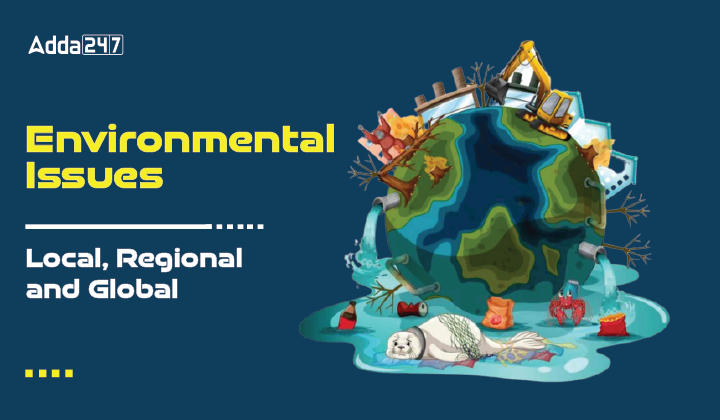Table of Contents
Environmental issues pose significant challenges at various scales, ranging from local communities to entire regions and the entire planet. These issues can have wide-ranging impacts on ecosystems, human health, and the overall well-being of both present and future generations.
Environmental issues
Environmental issues are problems, challenges, or concerns related to the state of the natural world and its interactions with human activities. These issues often have far-reaching consequences for the environment, as well as social, economic, and health implications. Some of the prominent environmental issues include:
Environmental acts in India
| Acts | Year |
| The Air (Prevention and Control of Pollution) Act | 1981 |
| The Water (Prevention and Control of Pollution) Act | 1974 |
| The Environment (Protection) Act | 1986 |
| The Hazardous and Other Wastes (Management and Transboundary Movement) Rules | 2016 |
| The Noise Pollution (Regulation and Control) Rules | 2000 |
| The National Green Tribunal Act | 2010 |
Local Environmental Issues
Local environmental issues refer to challenges that directly affect specific areas or communities.
Air pollution:
- Air pollution is a common local problem, caused by vehicle emissions, industries, and household activities.
- These emissions release pollutants such as particulate matter, nitrogen oxides, and volatile organic compounds into the atmosphere, leading to poor air quality.
- Localized air pollution can contribute to respiratory problems, allergies, and other health issues among the population living in these areas.
Water pollution:
- Water pollution is another significant local environmental concern.
- Contamination of water bodies can occur due to industrial discharges, improper waste management, or agricultural runoff.
- Toxic substances and pollutants can enter rivers, lakes, and groundwater, posing a threat to aquatic ecosystems and the health of local communities that depend on these water sources.
Deforestation:
- Deforestation is a local issue with widespread consequences.
- The clearing of forests for urbanization, agriculture, or logging disrupts local ecosystems, leading to habitat loss for countless species.
- Deforestation also contributes to soil erosion, exacerbates climate change by reducing carbon sinks, and threatens the livelihoods of indigenous communities who rely on forest resources.
Noise pollution:
- Noise pollution is a local problem that negatively impacts both humans and wildlife.
- Excessive noise from traffic, construction sites, or industrial activities can lead to stress, sleep disturbances, and hearing problems for individuals in the affected areas.
- Wildlife species, especially those residing near urban environments, suffer from habitat disruptions and communication interference due to high noise levels.
Regional Environmental Issues:
Regional environmental issues transcend local boundaries, impacting broader geographical areas.
| Regional environmental issues | Explanation |
| Water scarcity |
|
| Land degradation |
|
| Loss of biodiversity |
|
| Acid rain |
|
Global Environmental Issues:
Global environmental issues have far-reaching consequences that transcend national borders and affect the entire planet.
| Global environmental issues | Explanation |
| Climate change |
|
| Ozone depletion |
|
| Plastic pollution |
|
In conclusion, addressing these environmental issues requires collective efforts at all levels, from individuals and local communities to governments and international organizations. Promoting sustainable practices, conservation efforts, the adoption of clean technologies, and policy measures that prioritize environmental protection are crucial steps towards mitigating the impacts of these issues and creating a more sustainable future.
Download UGC NET Paper 1 Study Notes PDF
The direct link to download UGC NET Paper 1 Study Notes PDF has been given below. Candidate must click on the below link to download environmental issues Study Notes PDF.
Download Environmental Issues Study Notes PDF
| UGC NET Important Links | |
| UGC NET 2023 Notification | UGC NET New Syllabus |
| UGC NET Previous Year Papers | UGC NET Study Notes for Paper 1 |




 HPSC Assistant Professor Final Answer Ke...
HPSC Assistant Professor Final Answer Ke...
 HPSC Assistant Professor Question Paper ...
HPSC Assistant Professor Question Paper ...
 HPSC Assistant Professor Admit Card 2025...
HPSC Assistant Professor Admit Card 2025...




